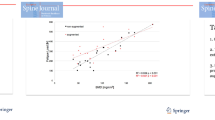Abstract
Purpose
Minimally invasive techniques that introduce cement and bone substitutes inside the fractured vertebral body are a new treatment line with clinically proven efficacy. However, mechanical behaviours between different fillers throughout fracture evolution is yet to be clarified, as many substances are available for introduction into the vertebral body fracture.
Methods
We comparatively studied biomechanical properties of tricalcium phosphate, tricalcium phosphate with bone morphogenetic protein (rhBMP-7) and autologous bone marrow aspirate with rhBMP-7 in vivo to determine what substance is optimal for repairing vertebral lesions in a porcine model. This biomechanical study was carried out with an Instron-type testing machine. Data registered were necessary strength to reach vertebral fracture [Newtons (N)], shortening (millimeters) of the vertebra, energy absorption until vertebral fracture (Joules) and vertebral unit stiffnesss.
Results
For statistical study, we used the SPSS 16 package at a significance level of α = 0.05. In the presentation of the results, mean, standard deviation of mean, median and interquartile range (IQR) were analysed. Mean and standard deviation (SD) of strength in newtons (N) for the vertebral fracture are 756 N (SD = 253) in group 1, 1,500 N (SD = 1598) in group 2 and 1,230 N (SD = 1,598) in group 3. Stiffnesss after fracture was 229 N (SD = 123) in group 1, 277 N (SD = 135) in group 2 and 404 N (SD = 325) in group 3.
Conclusions
The association of tricalcium phosphate and BMP-7 generates major vertebral resistance to external energy, the cause of such fractures. In such fractures, minor shortening occurs as soon as the vertebral body is fractured. Autologous bone marrow and BMP-7 provides increased biomechanical behavior, and the vertebral body is thus significantly strengthened.







Similar content being viewed by others
References
Riggs BL, Melton LJ 3rd (1995) The worldwide problem of osteoporosis: insights affored by epidemiology. Bone 17:S505–S511
Silverman SL (1992) The clinical consequences of vertebral compression fracture. Bone 13:S27–S31
Melton LJ 3rd, Kan SH, Frye MA et al (1989) Epidemiology of vertebral fractures in women. Am J Epidemiol 129(5):1000–1011
Cooper C, Atkinson EJ, O’Fallon WM, Melton LJ 3rd (1992) Incidence of clinically diagnosed vertebral fractures: a population based study in Rochester. J Bone Miner Res 7(2):221–227
Lindsay R, Silverman SL, Cooper C et al (2001) Risk of new vertebral fracture in the year following a fracture. JAMA 285(17):127–132
Lyles KW, Gold DT, Shipp KM, Pieper CF, Martinez S, Mulhausen PL (1993) Association of osteoporotic compression fractures with impaired functional status. Am J Med 94:34–40
Longo UG, Loppini M, Denaro L, Maffulli N, Denaro V (2012) Osteoporotic vertebral fractures: current concepts of conservative care. Br Med Bull 102:171–189
Kim DH, Vaccaro AR (2006) Osteoporotic compression fractures of the spine; current options and considerations for treatment. Spine J 6(5):479–487
Galibert P, Deramond H, Rosat P, Le Gars D (1987) Preliminary noTe on the treatment of vertebral angioma by percutaneous acrylic vertebroplasty. Neurosurgery 33:166–168
Garfin S, Yuan HA, Reiley MA (2001) New technologies in spine: kyphoplasty and vertebroplasty for the treatment of painful osteoporotic compression fractures. Spine (Phila Pa 1976) 26:1511–1515
Dong R, Chen L, Tang T et al (2013) Pain reduction following vertebroplasty and kiphoplasty. Int Orthop 37(1):83–87
McGirt MJ, Parker SL, Wolinsky JP, Witham TF, Bydon A, Gokaslan Z (2009) Vertebroplasty and kyphoplasty for the treatment of vertebral compression fractures: an evidenced-based review of the literature. Spine J 9(6):501–508
Han S, Wan S, Ning L, Tong Y, Zhang J, Fan S (2011) Percutaneous vertebroplasty versus balloon kiphoplasty for treatment of osteoporotic vertebral compression fracture: a meta-analisis of randomised and non-randomised controlled trials. Int Orthop 35(9):1349–1358
Hillmeyer J, Meeder PJ, Nöldge G et al (2004) Balloon kyphoplasty of vertebral compression fractures with a new calcium phosphate cement. Orthopade 33(1):31–39
Lim TH, Brebach GT, Renner SM et al (2002) Biomechanical evaluation of an injectable calcium phosphate cement for vertebroplasty. Spine 27(12):1297–1302
Phillips F, Turner AS, Seim HB 3rd et al (2006) In vivo BMP-7 (OP-1) enhancement of osteoporotic vertebral bodies in an ovine model. Spine J 6(5):500–506
Pecina M, Giltaij LR, Vukicevic S (2001) Orthopaedic applications of osteogenic protein-1 (BMP-7). Int Orthop 25(4):203–208
White AP, Vaccaro AR, Hall JA et al (2007) Clinical applications of BMP-7/OP-1 in fractures, nonunions and spinal fusion. Int Orthop 31(6):735–741
Cubitt J, McAndrew A (2010) Management of tibial non-union with tricalcium phosphate and BMP 7. BMJ Case Rep. doi:10.1136/bcr.02.2010.2777
Busuttil K, Ayoub A, McMahonb J et al (2012) Mandibular reconstruction in the rabbit using beta-tricalcium phosphate (b-TCP) scaffolding and recombinant bone morphogenetic protein 7(rhBMP-7) e Histological, radiographic and mechanical evaluations. J Craniomaxillofac Surg 40(8):e461–e469
Giannoudis P, Dinopoulos H (2010) Autologous bone graft: when shall we add growth factors? Foot Ankle Clin 15(4):597–609
Kanakaris NK, Petsatodis G, Tagil M, Giannoudis PV (2009) Is there a role for bone morphogenetic proteins in osteoporotic fractures? Injury 40(Suppl 3):S21–S26
Conflict of interest
The authors declare that they have no conflict of interest.
Author information
Authors and Affiliations
Corresponding author
Rights and permissions
About this article
Cite this article
Manrique, E., Chaparro, D., Cebrián, J.L. et al. In vivo tricalcium phosphate, bone morphogenetic protein and autologous bone marrow biomechanical enhancement in vertebral fractures in a porcine model. International Orthopaedics (SICOT) 38, 1993–1999 (2014). https://doi.org/10.1007/s00264-014-2377-z
Received:
Accepted:
Published:
Issue Date:
DOI: https://doi.org/10.1007/s00264-014-2377-z




